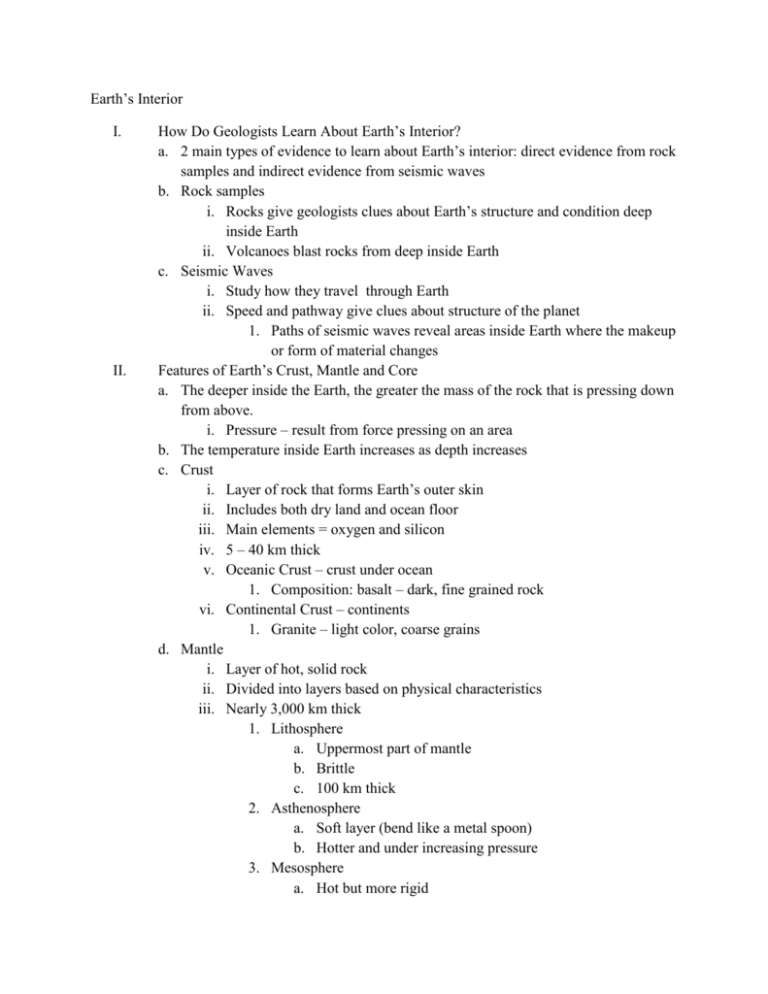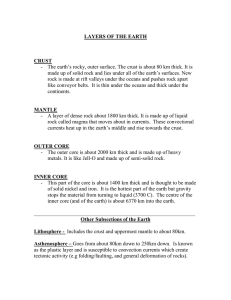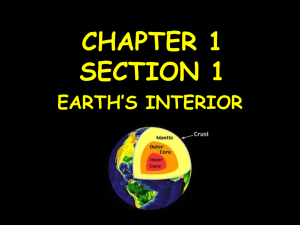Earth`s Interior How Do Geologists Learn About Earth`s Interior? 2
advertisement

Earth’s Interior I. II. How Do Geologists Learn About Earth’s Interior? a. 2 main types of evidence to learn about Earth’s interior: direct evidence from rock samples and indirect evidence from seismic waves b. Rock samples i. Rocks give geologists clues about Earth’s structure and condition deep inside Earth ii. Volcanoes blast rocks from deep inside Earth c. Seismic Waves i. Study how they travel through Earth ii. Speed and pathway give clues about structure of the planet 1. Paths of seismic waves reveal areas inside Earth where the makeup or form of material changes Features of Earth’s Crust, Mantle and Core a. The deeper inside the Earth, the greater the mass of the rock that is pressing down from above. i. Pressure – result from force pressing on an area b. The temperature inside Earth increases as depth increases c. Crust i. Layer of rock that forms Earth’s outer skin ii. Includes both dry land and ocean floor iii. Main elements = oxygen and silicon iv. 5 – 40 km thick v. Oceanic Crust – crust under ocean 1. Composition: basalt – dark, fine grained rock vi. Continental Crust – continents 1. Granite – light color, coarse grains d. Mantle i. Layer of hot, solid rock ii. Divided into layers based on physical characteristics iii. Nearly 3,000 km thick 1. Lithosphere a. Uppermost part of mantle b. Brittle c. 100 km thick 2. Asthenosphere a. Soft layer (bend like a metal spoon) b. Hotter and under increasing pressure 3. Mesosphere a. Hot but more rigid b. Transition zone – lies just beneath the asthenosphere e. Core i. Made up mostly metals iron and nickel ii. 2 parts 1. Liquid outer core a. 2258 km thick b. Layer of molten metal surrounding the inner core 2. Solid Inner core a. 1222 km b. Dense ball of solid metal c. Extreme pressure squeezes the atoms of iron and nickel so much that they cannot spread out to become liquid f. Core and Earth’s Magnetic Field i. Movement in the liquid outer core create Earth’s magnetic field. ii. Planet acts like a giant bar magnet iii. Compass points to Earth’s magnetic north pole which is not necessarily the same as Earth’s geographic North pole.











